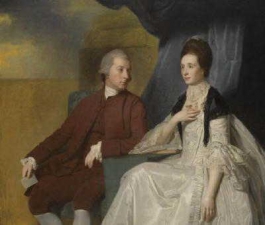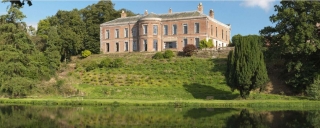
Sir John and Dorothy Chetwode, George Romney, 1769
Sir John Touchet Chetwode, the third Baronet of Oakley was a man who had everything. His wealth was derived not from hard work however, but from a series of propitious marriages.
The National Archive notes "The Chetwode family acquired their Cheshire estates through marriages to heiresses, viz. estates in the Nantwich - Sound area through the marriage of John Chetwode to the co-heiress of Johanna de Sound temp. Henry VI (see Ormerod, 1882 edn., vol.III, p.419); estates in Whitley area through the marriage of Philip Chetwode to Hester, daughter and heiress of William Touchet of Lower Whitley (d.1684) (see Ormerod, 1882 edn., vol I, p.662); estates in Agden - Hartford - Middlewich area through the marriage of Sir Philip Touchet Chetwode (d.1764) to Elizabeth, daughter and heiress of George Venables of Agden in 1727 (see Ormerod, 1882 edn., vol. I, p.540); and estates in Romiley - Werneth area through the marriage of Sir John Chetwode (d.1779) to Dorothy, third daughter and co-heiress of Tobias Bretland of Thorncliffe in 1756 (see Ormerod, 1882 edn., vol. I, p.662)."

The Chetwodes lived at Oakley Hall in Staffordshire (picture above). Oakley Chetwodes were a "young branch"of the Chetwode tree. An older branch had owned the Chetwode estate in Buckinghamshire from about 1086. By the 17th century, the younger branch bought the older's Buckinghamshire estate. This included 2,000 acres in Chetwode, Barton, Tingewick, Gawcott, Preston, Hillesden, and Prebend End.
Sir John was educated at Eton College and at St John's, Cambridge. In 1756 he married Dorothy Bretland an heiress. Through this marriage they gained estates in Romiley and Werneth and Ashton Under Lyne in Cheshire.
Sir John occupied his time managing the many estates and working as a judge. He travelled.
He seems to be have been drawn to London, and was a keen devotee of the Royal Society, a centre for scientific enquiry.. He was a regular visitor to the Grecian Coffee House in Temple Bar. This coffee house was where Fellows of the Royal Society met. In the early 18th century. Sir Isaac Newton and Edmund Halley, both Fellows, had dissected a dolphin on their coffee tables. Sir John became a Fellow of the Royal Society in 1767. According to the nomination, he was well versed in natural history.
While Sir John enjoyed London, his wife Dorothy stayed in Chester.
Dorothy Chetwode
Dorothy was a good choice of spouse for a family intent on growing their estates through marriage, but possibly a less happy love match.
"I wish I had more news to entertain you, but I hear none. I confine myself in the morning to my work, and in the evening I either have company or go out, but even then can hear no news. Every creature is so taken up with cards". she writes in a letter to her husband at the coffee house.
She rejects an extravagant gift from her absent husband who is perhaps impressed by London ways and perhaps saddled with a guilty conscience. "I am sorry you put yourself to the expense and trouble of diamonds, they are finery I had not the least ambition for....".
She asks him to buy silk with the instructions "it must not be blue, pink or yellow...". And then adds as an afterthought "It must not have too much white in it". I like to imagine he returned home with the wrong colour, notwithstanding her careful instructions concerning the colours he shouldn't buy.
Dorothy reassures her husband "I am quite well," but adds "and hope to keep so until your return.".
"I rest well in the nights," she cheers him. "But when I cannot sleep, I am quite uneasy and frighted to think how I shall get over my lying in.... it makes me very low spirited when I think about it."
Entertainingly she signs off the letter, in contradiction to her earlier idea of having no news "The reports of the widow Leg being dead, they say is false and without foundation. I am at all times your ever affectionate wife, Do. Chetwode."
Perhaps I read her letter with a 21st century eye.
Dorothy's death
Chetwode commisioned a portrait in Oakley where he appears (at last) sitting next to his wife.The painter is George Romney. This was a year when Romney had become fashionable. Romney painted portraits of wealthy families. See the Warrens and Leighs.. Sir John seems less finely dressed than both Mr Warren and Mr Leigh, although he was probably far richer. He wears working clothes, grips what looks like a notepad - a busy man, or perhaps a reference to science or law. His eyes are also devotedly on his wife. Hard to believe he has been absent so much!
It is good that he had finally returned, and had commissioned a painting, because she had less than a year to live.
Lady Chetwode's dress is fine, (white silk?) and she stares into the distance. Her hand is on her chest, and her unfocussed stare seems to me to suggest fragility, or possibly too much religion. Is she sick, or contemplating eternity?
The painting seems flatter and to have less attention to detail than Romney's others. Was it painted in haste? After her death? Was it painted by Romney at all?
Dorothy died on 30th December 1769. Four out of seven children survive her, two died the following year, one within five years and only one survived to adulthood.
Sarah Southam
After Dorothy's death John Touchet did not marry again. He continued to have children, however. But with his mistress, Sarah Southam.
Sarah is the reason for my study. She is my fifth great grandmother. She was the eldest daughter of a relatively well-off family in Winslow in Buckinghamshire who hit hard times when her father became bankrupt in 1762.
Perhaps she met Sir John at her uncle's estate in Barton Hartsorn, the next estate to the Chetwode's in Buckinghamshire.
Sarah had no property or estates, and Sir John didn't marry her. As a mistress with children she was vulnerable. But I am not sure whether she was actually more vulnerable than Dorothy. Certainly Sarah's older children were not recognised as Sir John's children when they were baptised. When the fourth son is born, however, both father and mother are named in full - Sir John Chetwode and Sarah Southam.
So why the change?
Sir John's untimely death
The Derby Mercury records that on 26th May 1779, just under one month before his youngest son was born, Sir John Chetwode sustained a contusion on his head when his carriage overturned in London. This was the last leg of his journey back to Westminster from the Chester Assizes where he had been presiding. He died.
It is clear from Sarah's choice of name and from the baptism record that she did not hide her son's father's identity. But her motivation doesn't seem to be to protect her son - she didn't need to.
Sir John's will identifies his illegitimate children as his, and he leaves them a sizeable inheritance - ultimately resulting in the families move to Ashton Under Lyne where they settle.
I suspect my fourth great grandfather is named John Justice Southam in celebration of his father, acknowledging him by name and celebrating his profession.
Sarah inherits a lease on a property in Oxford Street in London, and an income.
Codicil
Sir John updated his Will in 1778 after the birth of his second illegitimate son by Sarah when he increased her inheritance and the inheritance of her children.
He also added a clause which relates to a payment to a Marie Theresé Deville (previously unmentioned)
"[to] pay the [£]200 in one Month after my decease to Marie Theresé Deviller alias Marie Theresé Dumersay to and for her own use nevertheless upon this condition that she signs a Bond in the penalty of £200 to quit and leave the Kingdom of Great Britain in one [month] after the said [£]200 has been paid her and that in case she shall hereafter return into the Kingdom of Great Britain, she shall be liable to the penalty of the said Bond".